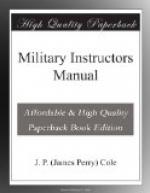(g) COMMUNICATIONS.—Communication is maintained by wireless, telegraph, telephone, signals, runners, carrier pigeons, aeroplanes, motor cars, patrols, and connecting files. Each unit usually maintains communication with the next higher command, and with similar commands on the flanks.
(h) NIGHT OPERATIONS.—They are used to minimize losses from hostile fire, to escape observation, and to gain time. The ground to be traversed at night should be carefully looked over in daylight. Some distinctive badge should be worn by our troops. The bayonet is chiefly used at night. Avoid firing. The enemy should be surprised. Place obstacles in front of your own lines at night. Usually 50 yards is the maximum range to fire at night.
(i) PATROLS.—“A commander may be excused for being defeated, but never for being surprised.”
PATROLS.
Commander selects leader, strength, gives it a mission, when to report back, and where to send messages. He gives it a number if more than one patrol is sent out, information of the enemy, and location of any friendly patrols that may be or have been sent out. Patrol leader is then allowed to ask questions.
Patrol Leader.—He should have a compass, watch, pencil, note-book, knife, and a map of the country. He should then do the following:
1. Assemble his men.
2. Inspect them.
a. To see if they are fit for this duty.
b. That they have no valuable maps or papers,
that their
equipment does not rattle or shine.
c. Rations and water.
3. He repeats the instruction that he has
received.
4. He explains any signals that are to be
used.
5. Designates a rallying point in case they
are scattered.
6. Details a second in command.
7. Takes a formation that will favor the escape
of at least one
man.
Conduct of the Patrol.—1. Move
cautiously but not timidly.
2. Do not flinch or show consciousness
of it in case you become
suddenly aware
that you are under the observation of the enemy.
Not knowing that
you are aware of his presence he will let you
come on, and suddenly,
when you see cover, make a dash for it
and escape.
3. Do not get lost.
4. Do not allow yourself to
think of the enemy as being in one
direction only.
5. In entering or passing through
woods take an extended skirmish
line formation.
6. In passing any short defile
bridge or ford, send one man ahead.
7. If you suspect the presence
of the enemy under certain cover, a
good way to find
out is to let one man approach within a
reasonable distance
and then, acting as though he had been
discovered, turn
and run. This will generally draw his fire.
8. Keep quiet. Forbid
unnecessary talking.
9. From time to time select
suitable rallying points in case you
become separated.
10. Remember that you do not fight
unless in self defense.




